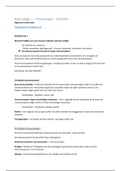Exam (elaborations)
N 5334 FINAL EXAM ADVANCED PHARMACOLOGY
- Institution
- University Of Texas - Arlington
NURS 5334 FINAL EXAM ADVANCED PHARMACOLOGY Exam (elaborations) NURS 5334 FINAL EXAM ADVANCED PHARMACOLOGY (NURS 5334 FINAL EXAM ADVANCED PHARMACOLOGY)
[Show more]












